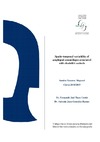Please use this identifier to cite or link to this item:
https://accedacris.ulpgc.es/jspui/handle/10553/74468
| Title: | Spatio-temporal variability of amphipod assemblages associated with rhodolith seabeds | Authors: | Navarro Mayoral, Sandra | Director: | Tuya Cortés, Fernando José González Ramos, Antonio Juan |
UNESCO Clasification: | 241705 Biología marina 310510 Dinámica de las poblaciones |
Keywords: | Amphipoda Population structure Rhodolith seabeds Algal biomass Bathymetric gradient |
Issue Date: | 2019 | Abstract: | Maërl (rhodolithic) beds are habitats underpinned by rhodoliths, which are distributed worldwide within the photic zone, from the intertidal down to 200 m depth. The morphology of individual rhodoliths is directly affected by physical processes, such as the degree of hydrodnamism and light availability, which typically change with depth. Concurrently, epiflora attached on rhodoliths can experience both seasonal and depth variation; consequently, epifauna living associated with rhodoliths can respond to such changes. In this study, we partitioned the relevance of scales of temporal (four seasons through two years) and spatial (three depth strata: 18, 25 and 40 m) variation on the diversity, structure and abundances of amphipod assemblages living in maërl beds of Gran Canaria Island (eastern Atlantic). . A total of 3,996 individuals, belonging to 32 taxa, were here identified. Multivariate analysis of the amphipod assemblage structure revealed consistent differences between depths; more diverse and abundant amphipod assemblages were observed at 18 and 25 m depth relative to 40 m. This pattern was particularly related to the epiphytic algal biomass, which was also greater at 18 and 25 m depth. Six species dominated the assemblage, accounting for ca. 75.5% of the total abundance, including: Gammaropsis ostroumowi, Ampithoe ramondi, Dexamine spinosa, Pardia punctata, Pseudoprotella phasma and Ampithoe helleri; these species showed larger abundances at 18 and 25 m than at 40 m. Among these species, G. ostroumowi and A. ramondi dominated the assemblage. For both species, ovigerous females were observed throughout the entire study, with larger abundances at 18 and 25 m for G. ostroumowi and A. ramondi. Juveniles of both species were exclusively recorded at 18 and 25 m, being absent at 40 m. A peak of juveniles of both species occurred in spring, most likely linked with the larger biomass of epiphytic algae. In summary, this study has demonstrated that the assemblage of amphipods associated with rhodolith seabeds can greatly vary across scales of both spatial (depth) and time (seasons), in particular due to variation in the amount of epiphytic algae attached to rhodoliths, which therefore seem to provide key resources for associated amphipods. | Department: | Departamento de Biología | Faculty: | Facultad de Ciencias del Mar | Degree: | Máster Universitario en Oceanografía por la Universidad de Cádiz, la Universidad de Las Palmas de Gran Canaria y la Universidad de Vigo | URI: | https://accedacris.ulpgc.es/handle/10553/74468 |
| Appears in Collections: | Trabajo final de máster |
En el caso de que no encuentre el documento puede ser debido a que el centro o las/os autoras/es no autorizan su publicación. Si tiene verdadero interés en el contenido del mismo, puede dirigirse al director/a o directores/as del trabajo cuyos datos encontrará más arriba.
Show full item recordPage view(s)
97
checked on Sep 16, 2023
Download(s)
128
checked on Sep 16, 2023
Google ScholarTM
Check
Share
Export metadata
Items in accedaCRIS are protected by copyright, with all rights reserved, unless otherwise indicated.
